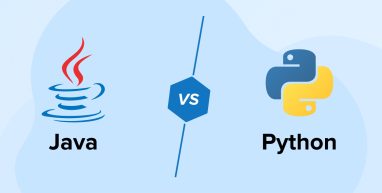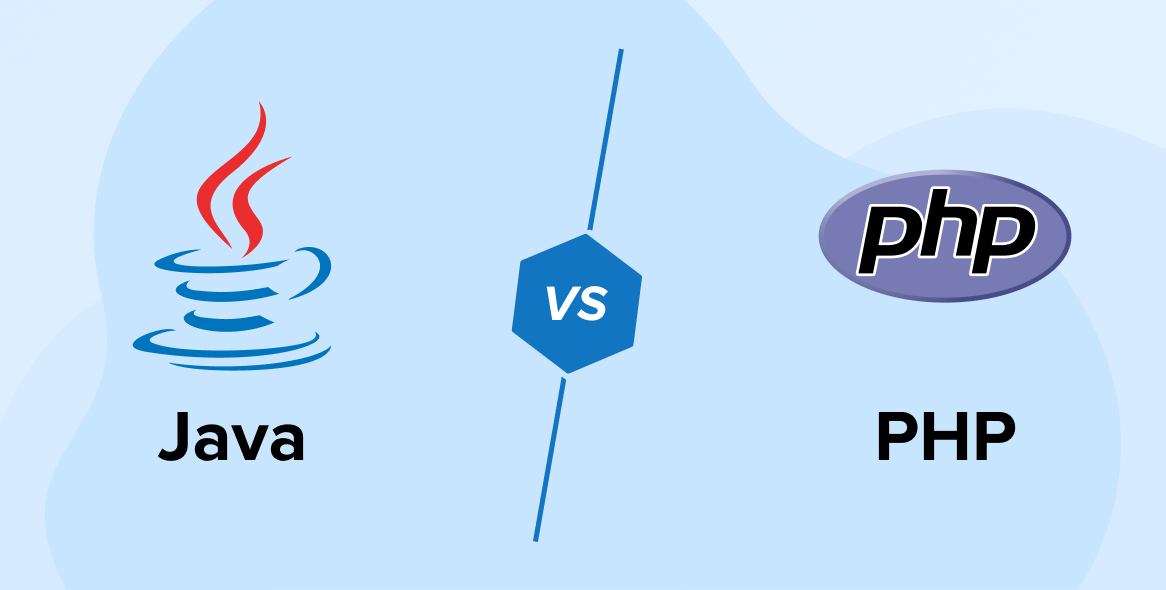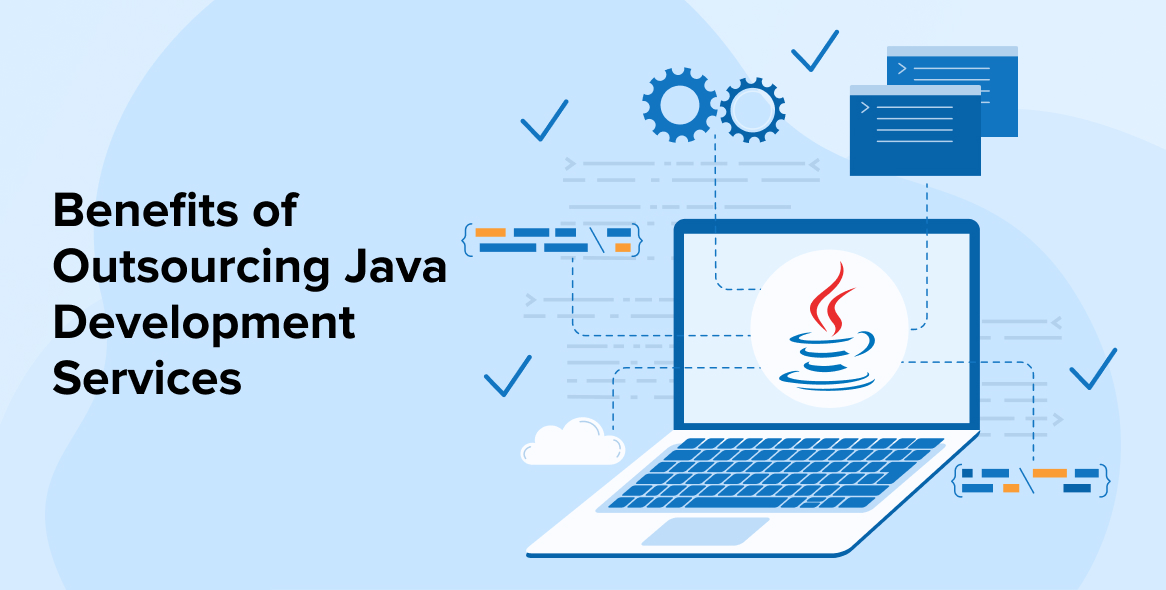
Java vs. Python is one of the classic comparisons often seen as old vs new. Both programming languages have unique features and come with a distinct set of pros and cons. If you can’t decide whether to collaborate with a reliable Java development company or hire expert Python developers for your upcoming project, then this blog is for you. It provides a detailed comparison between both languages to help you gain a deeper understanding of them and make an informed decision for your project.
1. Overview of Java
Java has been around since 1995. It is a versatile programming language and a platform that has gained significant popularity among programmers and web designers. Java is an object-oriented language that may be used for a variety of purposes. It is often considered a faster option since it is a compiled language, while Python is not. Java, a compiled programming language, has its code automatically translated into bytecode, which is then executed by the Java Virtual Machine (JVM). This allows for improved performance and better control over hardware factors like CPU utilization.
Java is widely utilized across various fields, including web development, big data analytics, and Android app development. It is also gaining popularity in the realms of cloud development and the IoT. Working on large-scale web applications and microservices in Java becomes useful. Many industries use Java to develop their online applications, including healthcare, education, insurance, and government. NASA, Google, and Facebook are just a few of the major corporations now employing Java.
1.1 Advantages of Java
Java is a popular programming language, and there are many reasons for it. Here, we discuss the key benefits of using Java for software development.
1. Platform-Independent
Java works on the principle of “Write Once, Run Anywhere”. Its practical implementation includes the Java Virtual Machine, which acts as an abstraction layer between the hardware and your Java programs that need to be executed on the platform.
All types of Java applications are compiled into bytecode, which is supported by the JVM. Each device has its own version of JVM, allowing Java applications to run on all kinds of platforms.
2. Object-Oriented Programming Language
Java is an object-oriented programming language that organizes code around objects rather than actions or logic. This helps promote code reusability and improve flexibility. Object-oriented principles involve breaking down large projects into smaller chunks. This makes it easy to fix a bug or release an update.
Managing your code is no longer overwhelming with object-oriented programming, even when working on large and complex projects. However, to ensure the proper implementation of OOP, Java developers need to follow a predetermined set of instructions using specific variables and functions, which are clustered by context.
3. Multi-Threaded Environment
Java supports multi-threaded programming. A thread is the smallest processing unit in programming that allows the app to perform a specific task. By using multiple threads, Java applications can handle multiple tasks simultaneously within a single program without affecting the overall app performance.
Interestingly, all these threads share the same memory area, so there is no extra burden on memory storage or CPU. This helps maximize the use of CPU time.
4. It’s Secure
Developers need a programming language that offers robust security features. It helps ensure the safety of the app and user data. Java’s built-in tools provide data encryption features for secure communication and preventing unauthorized access.
Moreover, the Bytecode Verification feature ensures that only verified code can run on the JVM, protecting apps from malicious inputs. Similarly, Java Class Loaders prevent unauthorized code from accessing the system, which mitigates cyber threats and strengthens runtime security. Java offers many more robust security features to maintain the integrity and confidentiality of app data.
5. Community Support
Java is one of the oldest programming languages on the market. It has a large active community of developers. The language offers many development benefits to developers. In return, they contribute to the advancement of the language by releasing subsequent versions, new frameworks, tools, and libraries, adapting to the latest trends, and fulfilling modern development requirements.
Community members assist developers in resolving their queries through platforms such as Stack Overflow. Moreover, different types of tutorials are available on the internet that cover multiple aspects of Java development.
1.2 Disadvantages of Java
No programming language is perfect. Despite providing numerous benefits, Java has some limitations as well. This section uncovers those limitations and dives deeper to see if it’s the right fit for your project or not.
1. Performance Limitations
The Java Virtual Machine is one of the major reasons behind its poor performance due to its runtime overhead. Moreover, memory management aspects like thread deadlocks, inadequate caching configurations, and garbage collection can further degrade performance if not handled effectively.
Additionally, Just-In-Time (JIT) compilation requires some time to interpret and compile the Java bytecode into native machine code during runtime, which could give way to performance issues. Therefore, it is crucial for Java developers to carefully manage memory and system resources to avoid performance degradation.
2. GUI Look and Feel
Compared to apps developed using modern languages, Java-based app designs often lack the elegant look and smooth functioning of the graphical interface. To users, the look and feel of Java apps may seem outdated in comparison to modern applications. Moreover, when building native apps, Java can’t fully replicate the seamless performance and platform-specific look and feel that native development tools provide.
3. Verbose and Complex Codes
Java’s syntax requires developers to write more lines of code and boilerplate to define even basic functionality compared to other languages. As a result, your code becomes complex and verbose, making it difficult to read and understand.
4. Licensing Costs
Initially, Java was available as a free programming language, but Oracle later declared that it would start charging for Java for its business, commercial, and production use. Customers need to pay for bug fixes and updates per processor or number of users.
These kinds of commercial licensing costs are a cause for concern, and businesses must be aware of them before employing Java in their projects.
2. Overview of Python
Python was first released to the public in 1991 by its creator, Guido van Rossum. The language is designed with a philosophy that emphasizes code readability and simplicity. One key feature of Python is its interpreted nature, where each command is executed line by line.
Python has a more compact syntax than Java, which can make it easier to learn and test applications with less time and effort. Unlike Java, which requires compilation of the whole program before execution, you may run it as you type lines into the terminal. Other popular interpreted languages include JavaScript, in addition to Ruby and PHP.
Python allows programmers to use different approaches to coding at once. Because of its flexibility, Python may be employed for more than just object-oriented programming. According to Google Trends, Python has become more popular than Java.
The programming community widely uses Java for both server-side and client-side projects. However, data scientists and machine learning professionals frequently utilize Python because of its many helpful libraries, such as Scikit-learn and Pandas. Platforms like Google Search, iRobot, and YouTube would not exist without this language’s involvement in their creation.
2.1 Advantages of Python
Python is a popular, powerful, and flexible programming language with a vast ecosystem. It offers a large array of benefits, including:
1. Strong Community Support
Python has one of the largest and most active communities in the world. A plethora of resources is available in the market to support Python developers, along with numerous blogs and forums on the internet.
The Python community consists of contributors with varying levels of expertise, ensuring that the programming language remains up-to-date through frequent updates or bug fixes and by releasing new frameworks or libraries.
PyCon is a global Python conference that offers an opportunity for community members to connect and collaborate on various projects, solve issues, and drive innovation. The community also provides detailed documentation and tutorials to help beginners start their journey with Python seamlessly.
Like Java, Python is cross-platform and runs on macOS, Windows, and Linux, requiring only a native interpreter for that system.
2. It Offers Extensive Libraries
Python has an extensive library that supports common operations and functionalities. This library includes modules and packages that can be used for a variety of purposes, such as document generation, unit testing, and handlink Common Gateway Interface (CGI) scripts.
3. It Offers a More Flexible Approach to Programming
Python is a flexible programming language that offers developers a variety of programming paradigms to choose from. This flexibility is beneficial not only for programmers who value versatility but also for startups and young businesses that may need to pivot quickly to changing requirements.
4. It’s Free and Open-Source
Developers and business owners can use Python for free because of its open-source license. The language can be easily modified and redistributed without any costs. Using a free programming language could drastically reduce your development costs. It doesn’t need any particular platform and is compatible with every type of device and operating system. Python offers all the necessary frameworks, libraries, and modules required for a development project for free.
5. It May Boost Productivity
Python comes with a simpler syntax, making it easy to read. This allows developers to focus on creating solutions instead of spending most of their time understanding the code. As a result, Python can save a lot of time and effort during development. Moreover, Python supports dynamic typing, which automatically assigns data types to variables at runtime while writing the code.
So, Python developers no longer need to declare variables and data types. Now, the variable is not of concern until code execution, allowing developers to focus on their work and get many more things done. This significantly increases developer productivity.
2.2 Disadvantages of Python
Every programming language has its pros and cons. Python is indeed a robust and feature-rich language, but developers may face some challenges upon its implementation. This section discusses a few important disadvantages of Python.
1. It Only Executes One Thread at a Time
Python’s Global Interpreter Lock (GIL) limits execution to a single thread at a time, which can hinder the performance of multi-threaded CPU-bound programs. A viable alternative for multithreaded programs in such cases is the use of multiprocessing software.
2. It isn’t Mobile Native
Python can be effectively used for mobile application development, although it may require some extra work to find the appropriate libraries that provide the essential infrastructure. As an illustration, consider Kivy, which provides a consistent API for developing mobile apps that run on various platforms, including mobile devices and desktop software like Raspberry PI, Linux, and Windows.
3. It Uses a Large Amount of Memory
Memory usage might be a concern if you use Python for a project that requires managing several objects concurrently in the same memory area. NumPy provides efficient numerical computing tools that help address this situation. Compared to standard Python lists, NumPy arrays consume less memory and deliver enhanced performance for operations involving large datasets.
3. Comparison of Java vs Python
The following are some of the different comparison parameters of Java vs Python programming languages:
3.1 Comparing Syntax
Java has been popular among students for a long time due to its straightforward syntax compared to languages like C. Additionally, Java handles many operations automatically, such as memory management through garbage collection.
On the other hand, Python is easier to learn and test in small increments because its syntax is shorter and more like plain English. It relies heavily on indentation(white space), has no requirement to identify data disruptive types, and no brackets, semicolons, or strict naming rules, making it far more legible by humans.
Let’s take an example here:
Java
class DemoClass{ public static void main(String[] args) { System.out.println("Hello, World!"); int a = 3, b = 5; int sum = a+b; System.out.println("Sum of a + b is " + sum); } } |
Python
print('Hello, World!') a = 3; b = 5; sum = a + b; print(‘Sum of a + b is’, sum) |
Both Programs Print the following output:
Hello, World! Sum of a + b is 8 |
3.2 Performance
Java is an interpreted and compiled language, allowing it to ensure quick code execution and enhanced performance. Its static typing and JIT compiler help Java developers build high-performance applications.
On the other hand, Python is an interpreted language that doesn’t perform code compilation in advance. This gives way to several errors in the runtime that may end up crashing a Python program.
3.3 Stability
In Java, codes are subjected to compilation before running. If there are any errors in the program, the compilation process fails and returns errors. Thus, developers can know about the issues and vulnerabilities in their code before executing it in the production environment. As a result, Java code is better compiled, error-checked, reliable, and faster compared to Python.
Meanwhile, Python is an interpretive programming language that doesn’t provide precompilation services. As a result, many errors hidden in the Python code are only detected during runtime, which can affect the app’s performance and possibly make user and business data vulnerable to cyberattacks.
3.4 Portability
While both Python and Java are portable, Java has a slight advantage due to the Java Virtual Machine (JVM). Python can also be installed and executed on macOS, Windows, and Linux with only minor changes to the system environment. However, Python programs require a compiler to translate their source code into the language of the host operating system.
To run Java code, you need both a Java Virtual Machine (JVM) and a Java compiler. As technology has progressed, JVM has become widely available on most desktop computers, ensuring that developers can reach the vast majority of their target audience who will download and utilize the app.
3.5 Security
Java is more robust than Python, although both are considered safe languages. Java’s powerful login and access control features ensure the web application is safe from unauthorized access. Since Java employs bytecode, the JVM scans generated class files for malicious software whenever the compiler compiles the code.
Python is a straightforward programming language that is simple to debug. Writing simpler code reduces the likelihood of future complexity risks and makes debugging more efficient. While both Python and Java have strong safeguards in place, Java comes out on top.
3.6 Speed
Python’s straightforwardness, ease of use, and utility make for lightning-fast development. It is often the best option when time is of the essence. On the other hand, Java’s development pace is slower. The development time and size of a team needed for a Java project are typically higher.
Developing an MVP in Python takes a couple of weeks, while the same task in Java takes months.
3.7 Mobile App Development Compatibility
Mobile app developers need programming languages compatible with their targeted platforms or operating systems. Java is highly compatible with the Android operating system, making it a popular and preferred option for Android app development. Java’s Android SDK provides an extensive set of tools, libraries, and Android-specific APIs to help developers build high-quality mobile apps.
When it comes to creating mobile apps, most programmers do not choose Python because it is an interpreted language and so requires more storage space and computational speed at runtime. Python cannot develop native mobile apps, but frameworks like Kivy can be used to create cross-platform apps. Java provides the speed and seamless functionality that is ideal for mobile app development.
3.8 Code Readability & Formatting
Python’s unique syntax distinguishes it from other programming languages. It divides the code into sections by using indentation. People widely use Python because it is easy to learn and has excellent source code readability. Python makes it possible to write in only a few lines what would be much more complicated in other languages.
Example:
>>>x = 1 >>> if (x==1) : print(“Hello World”) #Separated by indents |
Java is not always the simplest language to learn. Java uses curly brackets to demarcate code segments. Even for basic reasoning, writing understandable code is a labour-intensive process that requires a large number of lines of code.
Example:
class readability_example { public static void main (String[] args) { int a = 1; if(a==1) //Separated by curly braces { System.out.println(“Hello World”); } } } |
3.9 Programming
Backend web development often uses languages like Python and Java. To put it simply, backend web development is the process of creating a system of programs that are hosted on servers. Both languages provide powerful frameworks and libraries for developing websites. Python is popular for backend development because of how simple its syntax is. Java’s static typing guarantees that the lines of code are error-free. Two popular web development frameworks written in Python are Flash and Django. Java’s Spring framework is a widely used web application framework. Python’s extensive libraries and package support have made it a popular choice in fields such as machine learning, AI, and Big Data.
Java’s high-performance frameworks have made it a popular choice for certain types of game development. For the best possible user experience in a game, the highest possible performance is essential, and Python is not the right tool for the job. Python is used in many different game scenarios, primarily as a scripting language. Great games can be made with the aid of robust game development engines like JMonkey.
4. Key Differences: Tabular Comparison
| Key Parameter | Java | Python |
|---|---|---|
| Compilation | Compilation is required for use in Java. JVM is the primary tool for this purpose. | Since Python is an interpreted language, it requires meticulous line-by-line inspection of all code. |
| Syntax | The syntax is difficult since it generates problems if semicolons or curly brackets are missing. | The syntax is simple to learn and retain, and it has many similarities to human speech. |
| Security | Java’s advanced identification and access control mechanisms ensure the web app’s continued security. | Python is not as durable as Java. |
| Portability | A Java program may be executed on any computer that has a JVM (Java Virtual Machine) installed. | Python’s portability is generally considered better than other languages. To run the Python code, the local machine must have an interpreter. |
| Stability | The program may be more reliable and less prone to crashes because of the extensive evaluation and setup required before it can operate. | Python is not as reliable as Java, despite its rapid development, because the syntax is tested at runtime in Python. |
| Performance | Java precompiles programs and passes out copies of the resulting bytecode. When compared to Python’s dynamic-typing syntax, Java’s static-typing syntax makes compilation quicker and simpler. | Python Code is compiled dynamically, making it less portable to other platforms. |
| Speed | There may be a need for larger development teams and more time for Java-based applications. | Rapid progress has been made since Python is so straightforward and effective. |
| Framework | Many different frameworks may be used with the Java programming language. Common examples are “Spring,” “Blade,” “Hibernate,” etc. | Python lacks Java’s extensive framework support. Some well-known ones are Django and Flask. |
| Learning curve | Java is a complex programming language that requires time and effort to learn and master. | Python is suggested for new programmers because of its accessibility and relative ease of use. |
| Readability | Java can only load up to 10 lines of code at a time from a file. | Python’s file reading code consists of simply two lines. |
| Architecture | The JVM executes Java programs and translates bytecode into machine language. | Python is compiled down to bytecode, which can run on any computer. |
| Database Support | Java provides a steady connection. Java has a widely adopted and frequently utilized database connectivity standard called JDBC. | Python provides very rudimentary network access. Python’s JDBC library provides less robust support for accessing databases. Therefore, it sees limited use in business settings. |
| Code example | Class Article {public static void main (String args[]) {System.out.println(“This is the best article on python vs java”);}} | Print in Python: print “This is the article on Python vs Java” |
| Machine Learning Libraries | Tensorflow, Pytorch | Weka, Mallet, Deeplearning4j, MOA |
5. Java vs Python: Which is Better?
Java is one of the most popular programming languages with a mature ecosystem. It is a go-to option for Android app development and ensures reliability, performance, and scalability for all Java-based solutions. Moreover, every subsequent version release brings significant improvements and benefits to software development.
Python has also gained worldwide support and is hailed for its ease of use, code readability, faster development cycle, and smaller learning curve. This programming language integrates well with modern technologies like AI and ML to help developers create innovative software solutions. Python is an ideal option for building small apps, prototypes, and cross-platform apps.
However, the decision of picking a suitable language depends mostly on your project requirements, such as speed, stability, performance, costs, and more. Additionally, other factors can influence this decision. One is the developer experience. If the team or the developer is new to software development, getting started with Python seems like a better option due to its simplicity and ease of learning.
However, if you or your team already have significant programming experience and are looking to learn a new language, then go for Java. It would help give you a deeper understanding of various programming concepts, helping you build a better software application.
Another factor is the domain of development. If you are looking for quick scripting, prototyping, web development, or data science app development, then Python is the right option. On the other hand, ensure robust performance and portability when developing enterprise apps, Android apps, and other large-scale systems by using Java.
6. Conclusion
Both languages have well-established, healthy communities that support their continued growth and longevity. Python’s dynamic typing may or may not be superior to Java’s static approach, and the choice between them often depends on individual or team preferences.. This debate has existed long before any of them were ever created. Java’s higher performance and stronger security may appeal to some developers. On the other hand, Python’s more streamlined syntax and the lower learning curve often make it more accessible. While neither Java nor Python is optimized for latency-critical applications, Java is significantly quicker.
Apart from the pros and cons of Java, it is still the best option for projects that require strict security standards or the development of mobile and business apps. On the other hand, Python is generally preferred for machine learning, data science, and rapid prototyping.






This is a great comparison of Java and Python! It's valuable to see the pros and cons of each language laid out clearly. Now I have a better understanding of which language might be a better fit for my next project.